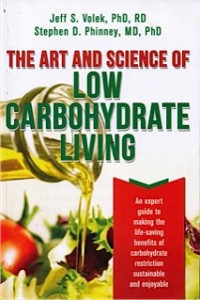 On May 16 th I wrote a post about the book The Art & Science of Low Carb Living by Jeff S. Volek PhD, RD and Stephen D. Phinney MD, PhD. I enjoyed the book. It was not a “how-to” book so much as a book about how the body and carbohydrates interact. If you read the book and buy into all the science behind a low-carbohydrate lifestyle the next thing you are going to want is a book that tells you how to live that lifestyle. The authors are kind enough to point to several books that they believe do just that. Two of the books they suggest are Protein Power by Mary and Dan Eades and The New Atkins For A New You buy them.
On May 16 th I wrote a post about the book The Art & Science of Low Carb Living by Jeff S. Volek PhD, RD and Stephen D. Phinney MD, PhD. I enjoyed the book. It was not a “how-to” book so much as a book about how the body and carbohydrates interact. If you read the book and buy into all the science behind a low-carbohydrate lifestyle the next thing you are going to want is a book that tells you how to live that lifestyle. The authors are kind enough to point to several books that they believe do just that. Two of the books they suggest are Protein Power by Mary and Dan Eades and The New Atkins For A New You buy them.
I read Protein Power almost a year ago when I was looking for guidance about how to transition into a gluten-free/wheat-free/grain-free household. I liked the book but ultimately I ended up following the guidelines of The Primal Blue Print by Mark Sisson.
I love The Primal Blue Print and always point people to it as a “starter guide”. Mark Sisson has what he calls his “carb curve”. It’s a great tool for getting started but sometime during the past year I decided it might be too broad/limiting.
The Primal Blue Print Carb Curve Levels:
- 0-50 grams/day = Ketosis and Accelerated Fat Burning
- 50-100 grams/day = Primal Sweet Spot for Effortless Weight Loss
- 100-150 grams/day = Primal Blueprint Maintenance Range
- 150-300 grams/day = Steady, Insidious Weight Gain
- 300 or more grams/day = Danger Zone!
I like the “carb curve”. I think it’s a great starting point but once your body settles into the Primal/Paleo way of eating I think the curve could use some tweaking on an individual level. Everyone is different, different levels of carbs will do different things for different people. In order to maintain any kind of a lifestyle change you have to find what feels natural and also what works. Squeezing yourself into one of the carb curb levels above may feel good at first but it may not be a natural fit for your body. That’s what makes it hard to sustain for the long run.
 The New Atkins For A New You is a guide to low-carb living that helps you find your perfect carb level. I didn’t LOVE the whole book. The authors suggest soy products and mention using canola oil often and even some pre-made snack bars (yuck). It’s not a diet book that promotes whole natural foods like all the primal/paleo books and blogs. It falls short in that regard but it does a great job explain how to determine the amount of carbs you (as an individual) can eat in a day to lose weight, maintain weight or gain weight.
The New Atkins For A New You is a guide to low-carb living that helps you find your perfect carb level. I didn’t LOVE the whole book. The authors suggest soy products and mention using canola oil often and even some pre-made snack bars (yuck). It’s not a diet book that promotes whole natural foods like all the primal/paleo books and blogs. It falls short in that regard but it does a great job explain how to determine the amount of carbs you (as an individual) can eat in a day to lose weight, maintain weight or gain weight.
The Primal “Curve” is great. It’s easy, just jump in and follow the levels outlined in the curve. If that works for you but it’s not feeling perfect you may want to read The New Atkins For A New You.
Here are some of the main themes/ideas in the book:
- NET Carbs: these are the carbs you count – grams of carbs minus grams of fiber.
- CLL: Carbohydrate Level for Losing – maximum number of carbs (minus grams of fiber) you can eat in a day and still lose weight
- OWL: Ongoing Weight Loss – phase 2
- ACE: Atkins Carbohydrate Equilibrium – this is the level of carbs that you can eat to maintain your weight. Anything above this will cause you to gain weight.
The book takes you through 4 phases:
- Induction: Maximum of 20 grams of Net Carbs a day. This is usually a 2 week phase, kind of jump start to get your body to transition from burning sugar as fuel to burning fat as fuel. This is when you may feel kind of tired and have those “carb flu” symptoms. The authors address this and explain that these symptoms aren’t from not eating enough carbs they are from lack of salt. They suggest that once your body starts to burn fat it processes salt differently and you need more. They explain several easy ways to add the extra salt back into your daily diet.
- OWL (Ongoing Weight Loss) Phase 2: This is where you start to tweak your carbs and find your personal CLL (carbohydrate level for losing) and head toward a lifestyle change that will be sustainable. You start adding (suggested) foods and increasing your net carbs by 5. You have to be careful of “carb creep” during this phase – eating way more carbs than you think you are eating because of sloppy tracking. This is the phase where you will find out how many carbs you can actually eat in a day and still lose weight. You don’t want to mess this phase up.
- Pre-Maintenance, Phase 3: They suggest moving to this phase when you are 10 pounds from your goal weight. There are other criteria but you’ll have to read the book to get the whole story. You add more foods while at the same time hitting your goal weight and maintain that weight for a month. A lot of diet books/guides stop here.
- Life-Time Maintenance, Phase 4: Ace, Atkins Carbohydrate Equilibrium. The amount of carbs you can tolerate on a given day without gaining weight. Your diet has changed into a permanent lifestyle.
The book really holds your hand through all phases. They give specific food lists and explain how to add foods, even what order to add foods back in. They explain what to do if added foods start to mess you up. They talk about trigger foods and cravings and how they are different. They explain water weight and why the scale isn’t your best tool for measuring success. The book also does a nice job guiding you to the right starting phase. Not everyone needs to start in induction.
“A typical adult’s body contains about forty quarts of water, but it can safely range between thirty-nine and forty-one quarts. Since each quart weighs 2 pounds, your body weight randomly varies across a 4-pound ‘gray zone’.”
The book does focus on more than weight loss. There is a lot of discussion about personal health, the same kind of stuff that people who go primal/paleo are looking for. It felt like a good guide when applied to a primal/paleo eating style. If you’ve been living a primal/paleo life for a while and find that you aren’t feeling as great as you did at the beginning you might want to dial in your carb level.
This book helped me in several ways. It helped me figure out ways to add more healthy fat into my diet (read my mayonnaise post). I can keep my carbs low but adding more fat was always hard for me – I mean how much bacon can a person really eat! A lot of books that I have read talk about not eating too much protein and increasing fat. I don’t know about you but I get hungry! There is only so much fat I can eat and if I’m not supposed to over do the protein, what’s left – CARBs. It gets confusing. This book has a great chart for how much protein a person should eat. They base the amounts on gender and height. The amount of protein they suggest for me is 17 ounces a day or 76 – 159 grams. THANK YOU! That may seem like a lot to some people but trust me I can eat it. I don’t eat that much everyday but by the end of a week my average is probably right on. I’m in the process of tracking all my food for my class. It will be interesting to see where my protein levels out.
So, to finish up, I do recommend this book but only to people who really like to dig into the details. If you are a person who finds the “carb curve” a perfect guide then you probably won’t enjoy this book. If, on the other hand you are looking for a more individualized carb scale this book will help you find that.
Eat Well, Feel Good, Have Fun!

I’m Amy a board certified holistic nutritionist, certified functional nutritionist and lifestyle practitioner and certified Life Coach. I help women in midlife understand the changing needs of their body so that they can stop dieting and lose weight permanently. At 56 I live what I teach. Don’t believe the story that your best years are behind you. They are not. Your best years are just starting!
